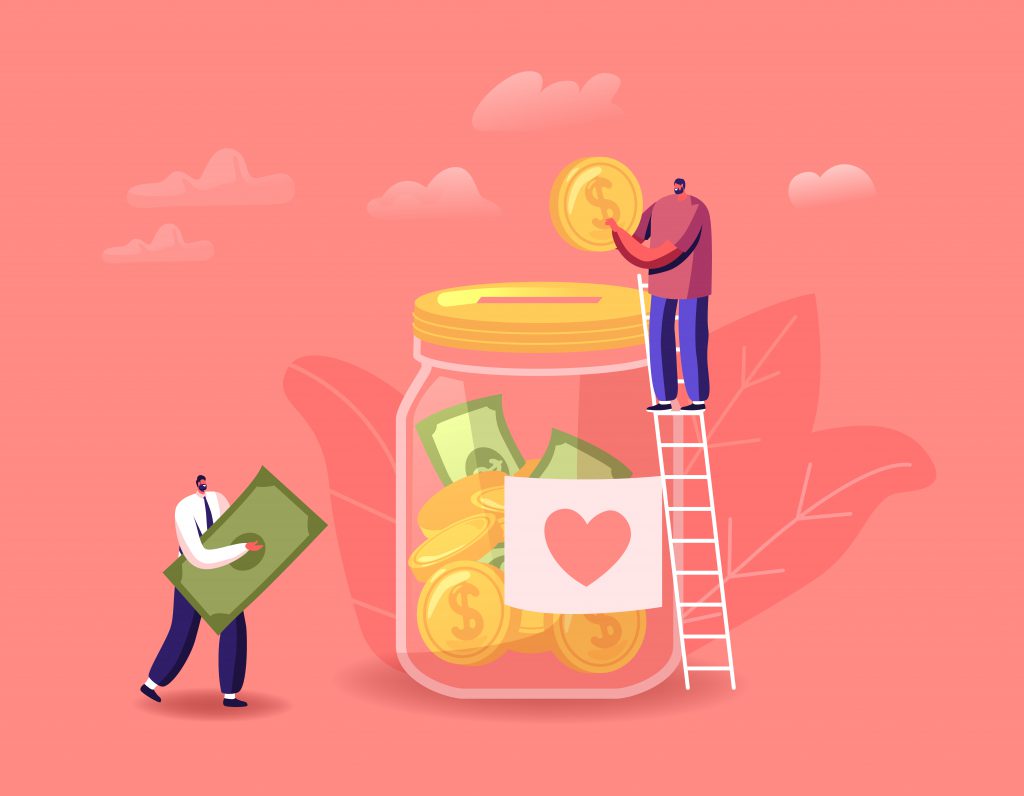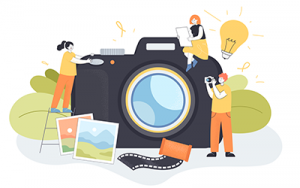What is Patreon?
Patreon is an online membership platform for creators and their audiences. It allows creators to have a direct relationship with their fans. Creators of all kinds can use Patreon to earn a monthly income. They do this by sharing exclusive content with their patrons on a subscription basis. Rewards and perks can take the form of newsletters, digital goods, forums, behind-the-scenes videos, etc.
Started in 2013 by musician Jack Conte and Stanford graduate Sam Yam, Patreon is now worth $4 billion (April 2021). After attracting more than 125,000 patrons in the first 18 months, the platform now has 3 million active monthly patrons.
Patreon allows artists to turn the support of their audience into financial backing. Backing that reflects the work that goes into their art. By sharing the full creative process with their patrons, creators can build a community around their work. One made up of people who understand how much time, effort, and money goes into creating content. This means that Patreon creators can earn an income that is based on the true value of their art. They aren’t just receiving pennies from ad revenue or relying on royalties, like on other platforms.
How does Patreon differ from other platforms?
Unlike platforms like Youtube or Facebook, Patreon creators don’t earn money from advertising. Instead, Patreon’s membership model is cultivating a creator’s economy. One which allows creators to commercialise their work whilst still owning it. Still being in charge of how it is shared. Who it is shared with. And perhaps most importantly, deciding (and receiving) its value. Although Patreon can offer some similar benefits to these platforms, this won’t exactly teach you how to become a YouTuber.
But Patreon’s subscriber model isn’t entirely new. Instead, it’s based on the concept of patronage; money given in support rather than for the purchase of a physical object.
Patronage meaning
For hundreds, if not thousands of years, artists have been supported in their work. Historically, wealthy individuals provided financial support to artists whose work they admired. They sponsored painters, musicians, and sculptors to create.
The patronage system was in place until the mid-19th century. Around this time, museums, theatres, and other types of mass audience participation became more popular. This meant that the Arts became more publicly available and thus supported. Rather than only being something the wealthy could enjoy. Or fund.
How does Patreon work?
Patreon allows users to generate a monthly income from their audience through a subscription model, quite similar to that of OddsMonkey. So how can Patreon work for you?
Who is Patreon for?
Patreon is for content creators and artists. According to their site, content creators from the following list of categories all make money on Patreon:
- Musicians
- Video Creators
- Podcasters
- Gaming Creators
- Visual Artists
- Communities
- Writers & Journalists
- Tutorials and Education
- Nonprofits
If your work falls into at least one of those categories, then Patreon could be perfect for you. Let your fans show their love for your work by offering them the chance to participate via a monthly membership. Reward them by giving them access to exclusive content, a community of like-minded fans, and insight into your creative process. If you want to sell photos online and make money from them, Patreon could work great when it comes down to this. However, the overall model gives you the freedom to ‘do you’ and focus on creating your best work, knowing that you have a steady income stream.
There are two types of users on Patreon: the artist and the audience. Or as Patreon calls them: Creators and Patrons. To make money on Patreon, you’ll need to join as a Creator.
How to become a Creator
- Sign up using a Google or Facebook account, or fill in the online form.
- Describe your content. Select up to two categories from the options available. They include: podcasts, videos, illustration and animation, and photography.
- If you decide to offer Patron-only merchandise, Patreon will handle production, global shipping, and customer support. Note: Merch for Membership adds 3% onto your Patreon plan fee. However, if you want to go down an alternative route when it comes to selling merch, you may want to check out how to sell tshirts online.
- Set up your basic profile, including as much info and personality as possible!
- Add membership tiers and the available rewards so that your audience can choose their monthly subscription.
- Create! It’s time to build your community and monetise the support of your existing social community. Remember to share your creative process along the way. Patrons exclusive / bonus content
Patreon plans and pricing:
There are three plans available to Creators on Patreon:
- Lite
- Pro
- Premium
All of the plans are free. However, there is a small fee on earnings which you’ll need to pay. Let’s take a quick look at the plans in more detail and who they’re best-suited for:
Lite
The Lite plan is perfect for Creators who are happy receiving flexible amounts, rather than fixed monthly subscriptions. This is a good option for someone who doesn’t want to have lots of tiers. Patreon takes 5% of your monthly Patreon income. With a Lite plan you get a hosted creator page, communication tools, and Patreon workshops.
Pro
The Pro plan is for creators who want to offer numerous membership tiers and be active in building their community. Patreon takes 8% of your monthly Patreon income. As well as everything in the Lite plan, Pro users get membership tiers, analytics, and unlimited app integrations.
Premium
The Premium plan is top level and is best-suited to a full-time creator. Someone with an engaged audience of at least 100,000 social media followers and a team around them. As well as the tools and features available to Lite and Pro users, Premium members get a dedicated partner manager and merch for membership. Patreon takes 12% of your monthly Patreon income
Whichever plan you choose, you’ll always be in ‘control’ of your audience. The direct Patreon Creator/Patron relationship is what sets the platform apart from its competitors. All Patreon Creators get:
- Develop and maintain direct relationships with your supporters.
- A range of business tools to track payments and lifetime value of your audience.
- No minimum payout amount.
- Customer support for your Patrons’ questions and payments.
- Dedicated Creator workshops to help you create a fantastic business.
- Access to the Patreon mobile app where you can keep an eye on things.
How much can you make on Patreon?
There’s no limit to the amount of money you can make on Patreon. In theory. Obviously, there are a load of factors that go into being successful. But how much you earn depends on your content and your audience. Build a meaningful relationship with loyal fans and make sure the rewards you offer are exciting enough to encourage them to part with their money.
Fundamentally, the idea would be to earn a wage that was big enough to allow you to focus on creating. Without having to worry about where your next paycheck was coming from. However, that’s not as easy as it sounds. In 2017, freelance photographer Brent Knepper wrote about his struggle to make the Patreon model work for him in the article “No one makes a living on Patreon”. Knepper talks about how the platform “filled [his] downtime, and became a full time job itself”. A year after starting, he’d managed to add just $516 (minus fees) to his annual Patreon income and acknowledged that “[i]t was a lot of work for little pay”.
But each Creator is different. Each Creator’s content is different. And each Creator’s Patrons are looking for something different too. Really, it all comes down to numbers. The larger your fan base, the bigger your potential patron pool. Most social media followings are made up of engaged/active and passive followers. Financial support is unlikely to come from someone who isn’t actively interested in what you do. They might ‘Like’ the odd post, but they’re not interested in paying you for content.
Influencer Marketing Hub created a tool to help you estimate your potential Patreon income. Obviously, this won’t tell you exact figures but it gives you an idea and an amount to aim towards.
Calculating your potential

In a 2018 blog, Patreon offered a similar example equation to help you estimate the potential income you might earn from your audience.

As you can see, there’s a big variation between the potential lower and upper monthly earnings given in the above example. Patreon isn’t a way to get rich quick, but it might help you fund your creative process. Building a strong community is imperative to your success.
Highest earners on Patreon
Not all Creators go public with their monthly Patreon earnings. However, there are a couple of lists which are based on the number of patrons and any declared earnings. For example, according to the ‘Top Patreon Creators’ list on Graphtreon, the True Crime Obsessed podcast has 45,277 Patrons with an estimated monthly income of between $125K – $337K (not public). Another podcast, Chapo Trap House, sits in second place with 36,880 Patrons and $163,712 monthly earnings (public). However, both of these Creators have built up an engaged fanbase over the last few years and produce quality, exclusive content for those supporters.
According to a March 2021 article, 6 out of the top 10 Patreon creators produce podcasts. These are ranked by their number of Patrons. However, if we look at a breakdown of the Top 5 monthly payouts Patreon makes to its Creators, we can see that the highest percentage is paid to Video content creators:
| Category | Monthly payouts |
| Video | $6,361,492 (25.7%) |
| Podcast | $3,633,593 (14.7%) |
| Adult games | $1,927,054 (7.8%) |
| Games | $1,902,700 (7.7%) |
| Music | $1,214,291 (4.9%) |
Source: Grapheon (updated daily).
Tips for increasing chances of success:
Know your audience
Take the time to truly get to know your audience. Who are you talking to? And what do they want from you? The whole point of Patreon is to build a community who are interested in you and your work. Now, if your patrons come from your pre-existing fanbase, you should already have a pretty good idea of what they like. You should know what content encourages high engagement. What works and what doesn’t work in terms of content. However, if you already know how to freelance and are taking your skills across to patreon as a fresh endeavour, you may need to distinguish what people may want to see from your future content.
Patreon is your opportunity to take this even further. To step up the interaction between you and your supporters. Use the tools available to you, such as polls and video chats to find out more about your patrons. These types of interaction throughout your creative process may help to fuel ideas.
You’re worth it
Your audience is already showing that they believe in your work by becoming patrons. So make sure your work is ‘worth’ their support. Focus on creating art that you’re truly proud of and your patrons will see the authenticity. They’ll feel like they are contributing towards the overall outcome.
And make sure that the rewards on offer are ‘worth’ their money. They are rewards, afterall. Keep your patrons updated with progress and involve them in your creative process. If you offer exclusive content, then you have to make exclusive content. Don’t recycle videos you’ve already used on other social platforms, for example.
Connection
This follows on from the point above, but the stronger the connection between you and your fans, the more likely they will be to stick by you long term. Don’t just pop up every now and again because you feel obligated to make an appearance. Instead, try to think of Patreon as an extension of your art/work. People want to see faces, not anonymous brands. They want to get to know the creator behind the creation. That’s why they’ve chosen to support someone on an ongoing basis rather than through a one-off unit sale.
Live your niche and be authentic (people will be able to tell if you’re just paying lip service to being a creator or if you’re fully invested).
Keep your word
Because you’re able to talk directly to your fans you need to deliver on promises. There’s nowhere to hide. You need to hold yourself accountable for keeping your word when it comes to delivering. Both in terms of your work projects and the exclusive content for your patrons. If you offer monthly rewards as part of your tiers, make sure you keep your word. Got a live stream booked in? Go live! Promised exclusive physical content? Factor in the length of time it will take to fulfil this.
Obviously, things happen that are out of your control. That’s ok…IF you keep your patrons updated! Just be transparent and let them know what’s going on.
Competition
It’s good practice to keep an eye on your competitors. See what they do in terms of content creation and how they operate their Patreon platform. Don’t copy, but do take inspiration from Creators doing things well.
Cross channel promotion
Chances are that the majority of your Patreon subscribers came from your social media following. That’s great! You managed to encourage them to not only follow you across to another online platform, but also to subscribe. To support you financially. So it’s time to continue leveraging your social channels. Think about how you can use Instagram to attract new followers and then introduce them to the idea of Patreon. However, if this isn’t a platform you have established prior to creating a patreon, you may want to check out how to become an Instagram influencer.
Remember to always keep your brand consistent and the quality of your content high.
Alternatives to Patreon
While Patreon is the market leader in membership platforms, it’s not the only option. In fact, it is not the only way to make money online. With the make money online hub here at OddsMonkey, we have compiled a whole host of alternative side hustles you could potentially check out.
Moving on from that, we’ll now take a quick look at some of the other platforms on offer.
Buy Me a Coffee
The aim of Buy Me a Coffee is to make earning money from fans as simple as possible. Creators can ask for (the price of) a coffee, or monthly or yearly memberships. Similarly to Patreon, they then need to share exclusive content as a thank you!
Main benefits of Buy Me a Coffee:
- There’s no monthly fee and features such as email are free to use. (There is a 5% transaction fee).
- Supporters don’t need to have a Buy Me a Coffee account in order to support you.
- Get paid instantly to a PayPal or Bank account.
- Have 100% ownership of your supporters and export the list any time.
Ko-fi
Creators can use Ko-fi as a sort of online tip jar to help them reach a financial goal. It’s slightly different to Patreon in that it’s not all about monthly subscriptions. Instead, artists can ask for small donations to help fund their work.
Main benefits of Ko-fi:
- 0% fees on donations.
- Add a Ko-fi button or widget to your website or blog.
SubscribeStar
SubscribeStar is a membership platform for musicians, visual artists, and educators who produce engaging content on a regular basis.
Main benefits of SubscribeStar:
- There’s a 5% platform fee which comes out of your monthly income.
- Detailed analytics which give an insight into the performance of your profile page. Data is broken down into: “Star Profile Income”, “Tiers Breakdown”, “Subscription” and “Geography”.
Memberful
Patreon is an all-in-one solution for managing your membership business and Memberful is a membership solution you add to your website and integrates with tools like WordPress that you’re likely already using.
Main benefits of Memberful:
- Create the perfect subscription plan: Private podcasts / Sell digital goods / Newsletters / Courses / Communities / Send physical goods.
- Easy member management.
- Flat transaction fee of 10% on the Starter plan and 4.9% on the Pro and Premium plans.
The following platforms are a little different to the membership-model used by the examples above.
Kickstarter, IndieGoGo, and GoFundMe are rewards-based crowdfunding platforms. In that way, they’re similar to Patreon. However, these platforms are usually used to raise money for one-off projects, rather than an ongoing subscription.
It’s a good idea to do your research and decide what style of fundraising you want to do.
Other ways to make money online
There are other options when it comes to making money online. Matched betting is an online money-making technique that allows you to make a profit from the free promotional bets offered by bookmakers. Because you bet on and cover all potential outcomes, the only way you can lose money is if you make a mistake. Check out our ‘What is matched betting?’ guide to find out what you need to do to get started.






